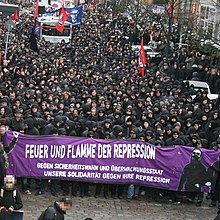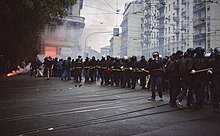Black block
The Black Block (also Black Block or Black Bloc ) is a demonstration tactic of groups that appear homogeneous to the outside due to their behavior and mostly black clothing and disguise . According to the Bavarian Office for the Protection of the Constitution, the uniform clothing should make it more difficult to assign acts of violence to individuals, so the perpetrators want to evade criminal prosecution. For others, uniform clothing serves to avoid identification by political opponents or employers. The black bloc's tactics include the threat and use of mass militancy in order to achieve political goals. The Black Bloc is not a fixed organization and mostly consists of groups and individuals from the left , autonomous and left-wing extremist spectrum. The tactic is also used by far-right groups - the Autonomous Nationalists .
Concept history
The term goes back to investigations by the federal prosecutor's office into the criminal offense of § 129a StGB against more than 50 people from Frankfurt am Main because of " membership in the terrorist organization Black Block" in 1981. It was picked up by the Autonomists and has been used increasingly in the media since then. Many of the autonomists use this term self-deprecatingly, because they consider its use to be defamatory.
Mark
In addition to clothing, the hallmark of black blocks at demonstrations is a determined to aggressive demeanor. Occasionally, people from the black bloc acted aggressively against the police and political opponents, erected barricades , threw paint bags and damaged shops. In addition, Black Bloc participants also set fire to vehicles and buildings.
The uniform black clothing and face coverings such as hoods, hats, sunglasses and scarves - sometimes also motorcycle helmets , gas masks and balaclavas - are intended to protect the demonstrators from being recognized by the police , state security or political opponents from the respective other political spectrum. In Germany , however, this has been a violation of the Assembly Act since the introduction of the ban on masking in 1985 .
History in Germany
The term Black Bloc came about with the emergence of the New Social Movements in the late 1970s , when increasingly autonomous people appeared at demonstrations of these movements such as the anti-nuclear movement and the peace movement. On May 1, 1980 in Frankfurt there was the first call for the black block. At that time, the appearance of the Autonomous but not as homogeneous as black as the heyday of the Black Bloc: early 1990s marched in Göttingen on the Antifa organized demonstrations of up to 2,000 people in the black block. At the beginning of the 1990s, the “ Autonomous Antifa (M) ” carried out demonstrations with the masked “Black Block” in a non-violent manner with non-partisan alliances.
In many actions, however, there were often real battles with the police, for example in the context of the squatting movement in the 1980s and 1990s, the movement against the West Runway at Frankfurt Airport in the early 1980s, the anti-nuclear movement in Brokdorf , Wackersdorf and Gorleben in the 1980s, at the so-called Berlin Revolutionary May Day from 1987, an alternative event of the left-wing radical scene to the traditional May Day rallies of the trade unions, the IMF Congress in Berlin , the occupation of the houses in Hafenstrasse in Hamburg in the 1980s. Since the late 2000s, left-wing and autonomous demonstrators have occasionally made use of the out-of-control tactic, as this means that hiking kettles and preventive police surveillance measures can be bypassed better than with a closed block.
Autonomous nationalists have been copying this tactic more and more since the 1990s .
Austria

In the demonstrations against the Vienna Academic Ball , a Black Block also marched from 2012, which caused serious riots, especially in 2014. Property damage occurred and the police were forced to intervene several times. Police officers and demonstrators were injured. The situation at Stephansplatz escalated, there was serious damage to property, some shop windows were smashed at Graben , a bank branch was attacked and a police cohort was forced to flee. In the courtyard, the demonstrators overran a weak police barriers, tore paving stones from the ground and pelted the local police station. A radio car of the ORF Vienna and several emergency vehicles of the Vienna police were destroyed with demolished traffic signs and concrete blocks. There were several arrests. The property damage was estimated at over a million euros the day after the protest, and half a million euros by the public prosecutor six months later. The police operation to secure the ball is also said to have cost one million euros.
Switzerland
The Black Block has been tangible in Switzerland since around 2000. The participation of the Black Bloc in May 1st demonstrations in Zurich has been making headlines since 2011 .
Italy
A black bloc caused a lot of destruction at the G8 summit in Genoa in 2001 . When dealing with these events, the suspicion was repeatedly expressed that the police had smuggled officers in disguise into the Black Block as provocateurs . Various eyewitnesses alleged that the police had cracked down on peaceful demonstrators with great severity, but that they were conspicuously reticent towards the Black Block.
France
In France, the Black Bloc has appeared sporadically since 2009, but especially on the occasion of May 1, 2018 in Paris and then increasingly during the weekly Saturday demonstration of the so-called yellow vests movement from November 2019; While the number of initially peaceful demonstrators steadily decreased after President Macron's government had partially yielded to the demonstrators' original demands, part of the movement became radicalized and was infiltrated by the black block - from then on, media coverage of the demonstrations was part of the riots and street fighting the police dominated.
United States

In the United States of America, the black bloc was probably first chosen as a form of protest in 1991 by the anarchist organization Love & Rage . In 1992 , a black bloc formed again on Columbus Day . The bloc, which was formed on November 30, 1999 by around 200 people to protest the globalization-critical protests in Seattle, received more media coverage . From the anonymous group, graffiti was sprayed and shop windows thrown in, which brought criticism from anarcho-pacifist groups to the marginalized militant anarchist movement since the 1920s , but the anarchist movement as a whole brought great attention and increased popularity. The debates that followed, similar to those that had been going on in German-speaking countries since the 1980s, revolved around the meaning and benefit of the action, damage to the reputation of the movement and the variety of tactics, or the sharp demarcation between militarized behavior and actions that cannot be publicly communicated.
Egypt
In Egypt , in the wake of the protests against the policies of President Mohammed Morsi, a violent group called the Black Bloc developed. This first appeared on January 24, 2013 on Tahrir Square in Cairo . The “Black Block” sees itself as a resistance to the thugs of the Muslim Brotherhood who arrested and tortured numerous members of the opposition in front of the presidential palace on December 4, 2012.
literature
- Carolin Behrmann (2013): “Indignati, guerriglia black bloc”: on the theory of colors in the law of assembly . In: Imagery of Knowledge . Art history yearbook for visual criticism. Akademie Verlag, Berlin 2013, 1, pp. 19-27.
Web links
- Black blocks right and left. Autonomous extremists on course for violence. An event by the Office for the Protection of the Constitution on June 24, 2010 in Potsdam (PDF)
- Why a revolutionary / black bloc . from buendnis-gegen-rechts.ch in the Internet Archive
Individual evidence
- ↑ Blocs, Black and Otherwise , Crimeth Inc. November 20, 2003, accessed December 8, 2017 from the Internet Archive
- ↑ bayern-gegen-linksextremismus.bayern.de
- ↑ What is the “Black Block”? ( Memento from June 8, 2009 in the Internet Archive ) tagesschau.de accessed May 26, 2008
- ↑ tagesspiegel.de
- ^ Philipp Wittrock: Black neo-Nazi bloc alarms police and politics. In: Spiegel Online . May 15, 2008, accessed November 29, 2014 .
- ↑ verassungsschutz.bremen.de
- ^ AG Grauwacke: Autonomous in motion. From the first 23 years , Berlin, Hamburg, Göttingen 2003, p. 18.
- ↑ Black block attacks police - demo disbanded. In: welt.de. May 1, 2012, accessed November 29, 2014 .
- ^ De Maizière calls for the Democrats to join forces . In: Spiegel Online. June 16, 2010, accessed November 29, 2014 .
- ^ Riots in Kreuzberg: The Black Block attacks. In: zeit.de. May 2, 2009, accessed November 29, 2014 .
- ↑ bz-berlin.de
- ↑ de.euronews.com
- ↑ André Zand-Vakili: The arsonists and the honest men. In: welt.de , accessed April 1, 2008
- ↑ Hubert Gude, Robert Vernier a. a .: "That's a shame". In: focus.de , accessed April 1, 2008
- ↑ rp-online.de ( Memento of the original from April 14, 2009 in the Internet Archive ) Info: The archive link was inserted automatically and has not yet been checked. Please check the original and archive link according to the instructions and then remove this notice.
- ↑ derstandard.at
- ↑ The Pope is dead! - 25 years of the Schwarzer Block. In: trend online newspaper , 6/2005 , accessed June 19, 2008
- ↑ Focus magazine
- ↑ Academic ball: "Police operation was a huge success" . January 26, 2014. In: kurier.at , accessed on October 1, 2019.
- ^ Opponents of the academics ball riot in Vienna. In: Spiegel Online . Spiegel.de, January 24, 2014, accessed October 1, 2019 .
- ^ Academic Ball: Riots in the city center. In: Der Standard , January 25, 2014. From DerStandard.at, accessed on October 1, 2019.
- ↑ Roland Winkler: Damage millions and criticism of rioting - arrests, injured, destroyed cars. ORF.at, January 25, 2014, accessed on October 1, 2019 .
- ↑ Academic Ball: Massive criticism of the police and rioters. In: Der Standard , January 25, 2014. From DerStandard.at, accessed on October 1, 2019.
- ↑ swissinfo.ch
- ↑ Tamer and Frustrated Black Block . In: Neue Zürcher Zeitung , May 1, 2014
- ↑ Memory of Genoa on the Deutschlandfunk website
- ^ A b Clemens Wergin: Italian Enlightenment . In: Tagesspiegel , July 24, 2002: “What happened is largely known: For days the violent demonstrators of the so-called“ Black Block ”were allowed to let off steam almost undisturbed, while instead peaceful demonstrators were repeatedly beaten up, or cameramen and photographers did a strange Wanted to document the type of cooperation: between the police and hooded violent criminals. The photo and film material is overwhelming: the police systematically smuggled in agents provocateurs who kept meeting their units, discussing plans of action and working out tactics. This also explains the reluctance of the police, even if riots took place right next to their own hundreds. "
- ^ V men in the Black Block . In: Der Spiegel . No. 36 , 2002 ( online ).
- ↑ LCI: Qu'est-ce que le "black bloc", cette stratégie utilisée par les manifestants d'ultragauche? , April 30, 2019, accessed on May 2, 2019 (French)
- ↑ Gabriel Kuhn : "New Anarchism" in the USA . Unrast Verlag , 2008, ISBN 978-3-89771-474-8 , p. 83
- ^ The opposition struggles - the Muslim Brotherhood act ( memento from January 27, 2013 in the Internet Archive ) In: tagesschau.de , accessed January 26, 2013
- ↑ General warns of the collapse of Egypt . In: diepresse.com


